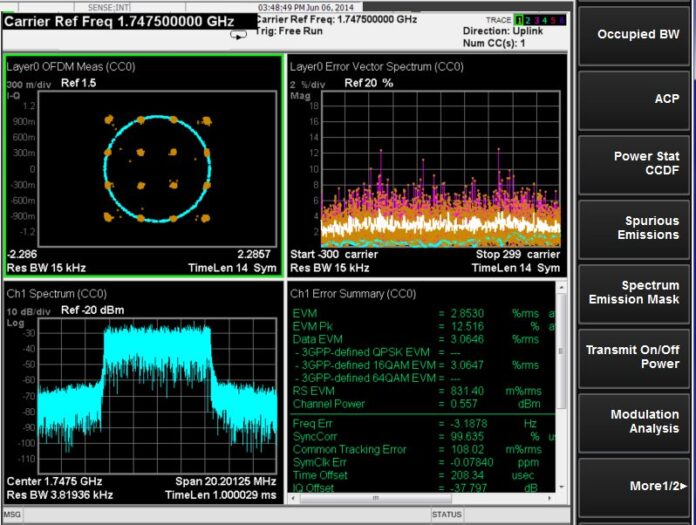LTE-Advanced testing continues to make progress across the ecosystem. In this week’s test and measurement news:
• Anritsu said that its ME7873L RF/RRM conformance test system has received Global Certification Forum approval for more than 80% of radio frequency and radio resource management conformance test cases for TD-LTE carrier aggregation. That 80% milestone is required for terminal/user equipment certification by GCF standards. The test system is being used for carrier acceptance testing in North America, Asia and Japan, according to Anritsu.
“China is deploying LTE-Advanced services using TD-LTE technology beginning this year, and Japan and the USA are planning introduction of these services, as well,” said Bob Kersey, director of wireless testing solutions for Anritsu, in a statement. “The GCF approval emphasizes our focus and commitment to obtaining GCF/PTCRB certifications to help bring next-generation mobile broadband systems to market as soon as possible.”
• Keysight Technologies is also responding to the need for LTE-A testing capabilities. The company announced expanded LTE-A testing for its E7515A UXM wireless test set, focused on three-component-carrier, carrier aggregation and the ability to validate 450 Mbps downlink speeds with three 20 MHz component carriers. The system also can test two CC uplink for both FDD and TDD and intra-band measurements. Keysight also said that the test set has enhancements for device validation that include eICIC for testing small cell interference, multicell mobility and 64QAM uplink modulation.
In addition, Keysight launched adjustable, integrated intersymbol interference capability for its J-BERT M802A high-performance Bit Error Rate Tester. The new programmable function allows engineers to to emulate channel loss for high-speed digital receivers and “streamlines test setup by eliminating the need for external cabling and the need to switch external ISI traces.”
“When [research and development] and validation teams characterize next-generation digital designs, they face several test challenges,” Keysight said in explaining the test scenarios and issues that the new function addresses. “As data rates continuously increase, channel loss between transmitter and receiver becomes more important. The loss is caused by printed circuit board traces, connectors and cables in the signal path. This channel loss results in ISI that depends on the channel material and dimensions, the data rate and bit pattern. All high-speed digital receivers are specified to tolerate a certain amount of total jitter, which typically includes some ISI caused by channel loss. During receiver characterization and compliance test, engineers need to emulate this loss. To emulate channel loss in the past, engineers used external trace boards that required external cabling and switching, which required time-consuming setup and contributed to test complexity.”
• Tektronix has a new compliance testing system for USB 3.1, expanding its capabilities in USB testing. The new receiver test solution supports the 10 Gbps data rate, as well as new tests for USB power delivery and type-C cables. The company said that USB testing “has become far more complex than in the past” due to the increasing speeds associated with the technology as well as the need to maintain backward-compatibility with older USB specifications and interoperability. Tektronix added that USB 3.1 designs also “must address challenging new requirements including 128b/132b encoding, lower jitter budgets, higher loss (with likelihood of integrated repeaters), and more complex equalization.”
• Rohde & Schwarz’s SwissQual brand has redesigned its website.
• If you’re looking for the details of the stockholder scuffle going on at JDSU, driving debate about whether to spin off both parts of the company into public entities or sell the optical business, I looked into that this week in this story.

